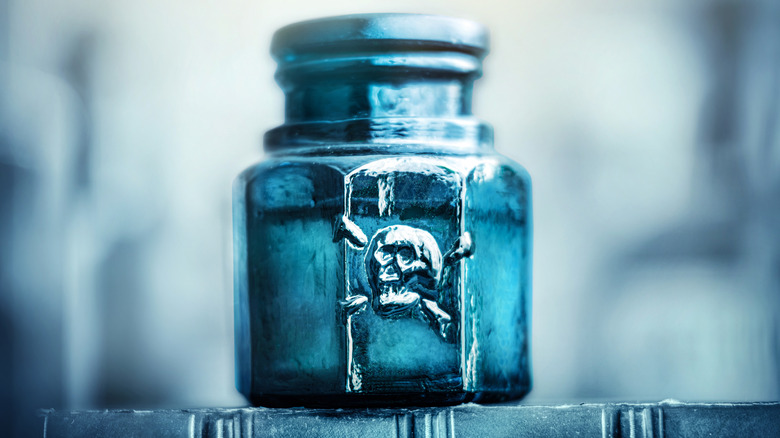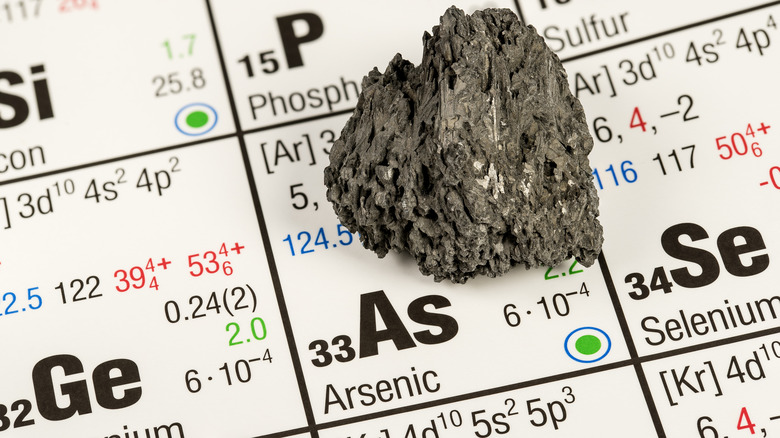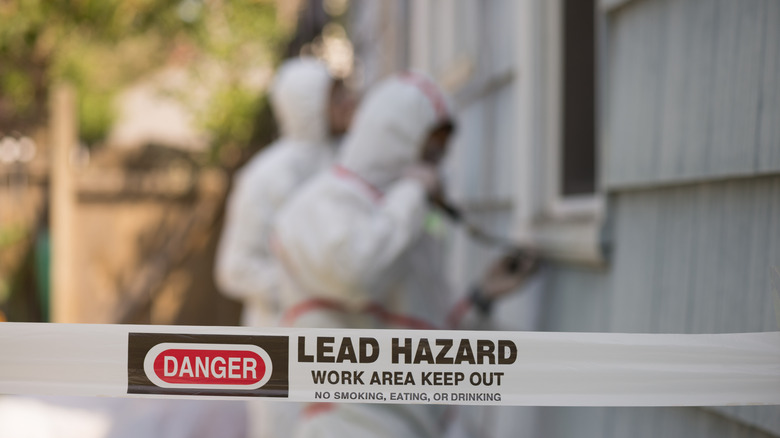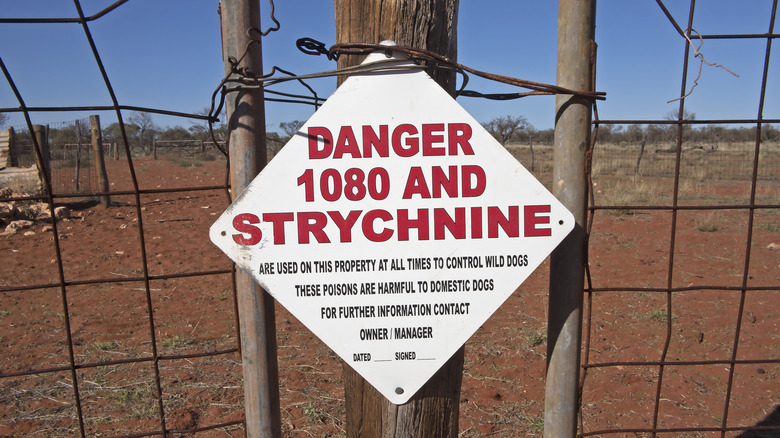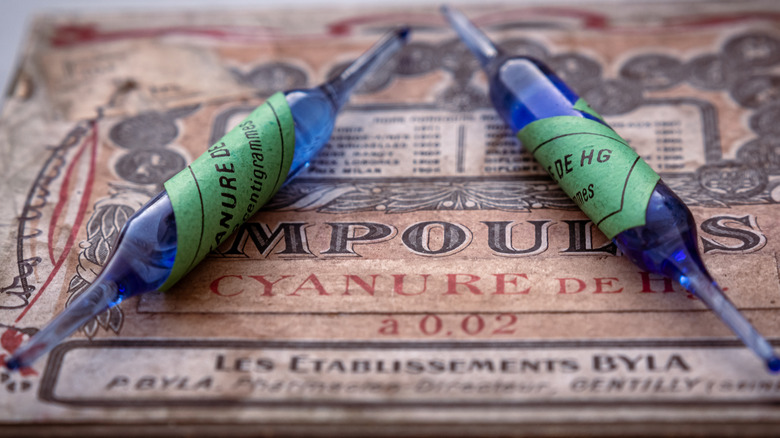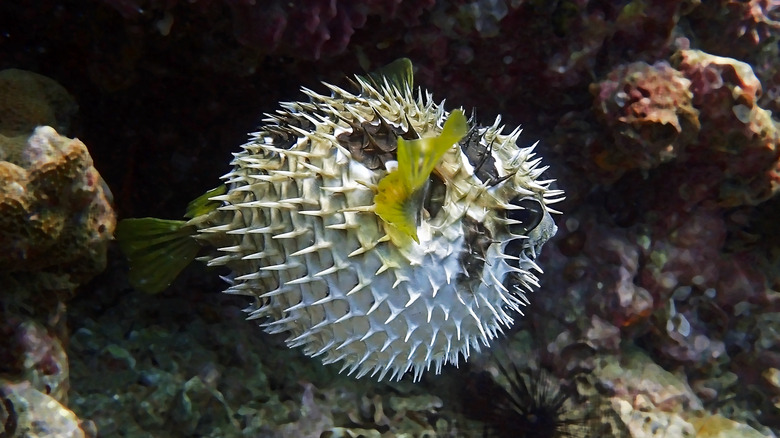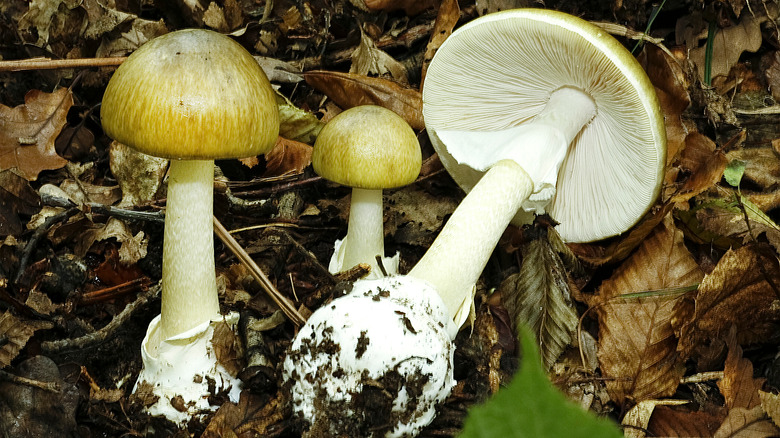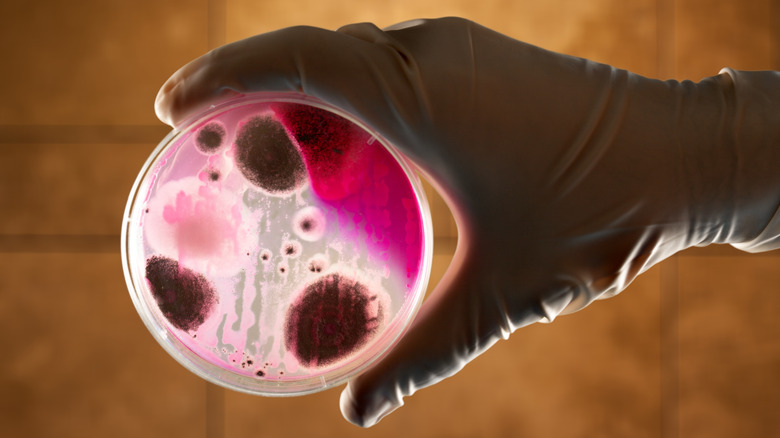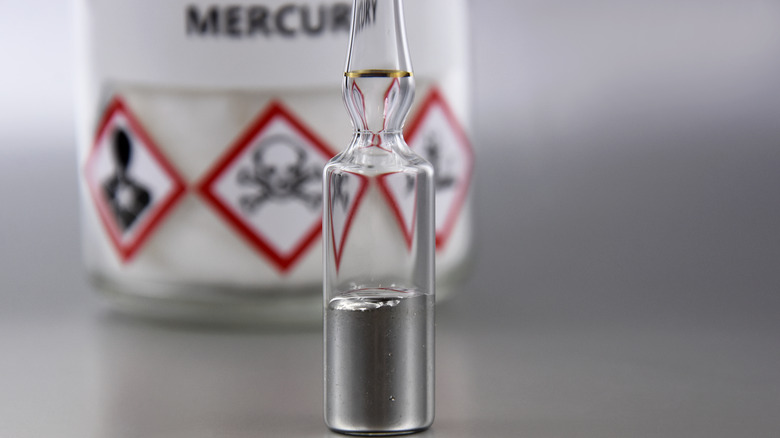Deadliest Poisons In The World
Let's start with the basics: What, exactly, is considered a poison? According to the Centers for Disease Control and Prevention, it's "any substance, including medications, that is harmful to your body if too much is eaten, inhaled, injected, or absorbed through the skin." Chemicals, drugs, gases... they're all considered poisons, as far as the Mayo Clinic is concerned, so here's the next question: How are the deadliest poisons determined?
Different poisons kill in different ways, after all, so there's a few ways researchers measure toxicity. According to the Canadian Centre for Occupational Health and Safety, two of the most useful are LD50 and LC50. That stands for Lethal Dose and Lethal Concentration, and it's basically a reference to how much of a substance is needed to cause fatalities in half of the animals tested. (Those are usually mice and rats, and don't worry — that's the most detail we're going to go into here.)
The results of these studies are then plugged into tables that define substances from extreme toxicity to not-at-all toxic. It's the former that's morbidly more interesting, so let's look at some of the deadliest poisons humankind has ever discovered or created... in no particular order.
The gas used in the most terrifying chemical attack of the 1990s
Most people might think that as they're going about their daily routines, they're pretty safe from things like catastrophic chemical attacks. That changed in 1995, when ordinary people going about their ordinary days found themselves breathing — and dying — from a gas attack on five Tokyo trains. Those behind the attacks were members of the Aum Shinrikyo cult, and according to the BBC, they killed 13 people. Thousands more were injured, and it was an escalation from an attack they'd carried out the previous year.
The gas was sarin: the packages left by Aum Shinrikyo contained a mixture that was made up of 30% of this deadly chemical nerve agent. According to the CDC, getting just a milliliter of sarin on the skin can be deadly, and it's a terrible way to die. The only good news is that with a large enough dose, it can happen in between 1 and 10 minutes, but the bad news is that with mild exposure, symptoms might not even show up for as long as 18 hours. Those include things like seizures, paralysis, respiratory collapse, a disruption in the function of the body's crucial system, and drowning in discharging fluids.
There's a good chance survivors will suffer permanent brain damage, and the worst part of this entire thing is that National Interest says Nazi-created agent continues to be used in terror attacks around the world.
There's a reason it's used so often in fiction
Arsenic might be the first poison that comes to mind for crime fiction, and there's a good reason for that. According to the Collaborative on Health and the Environment, it can take as little as .145 grams — or ⅛ of a teaspoon — to kill an adult. It makes such a great murder weapon because the effects can be delayed, and death can come with a series of slow, tiny doses and chronic exposure. Symptoms include all kinds of horrible things like a drop in red and white blood cell production, which then sets off a chain reaction throughout the body. There are also gastrointestinal problems, and — with long-term exposure — there's a high risk of certain cancers, nervous system disorders, and circulatory system malfunctions.
People have been killing each other with arsenic for a long time. One of the most famous cases might be that of Madeleine Smith, who was put on trial in 1857 for the death of her lover, Pierre Emile L'Angelier. The National Record of Scotland says it was the crime of the century — especially when the contents of their love letters went public — and when it was all over, a verdict of "not proven" was returned.
Arsenic is still being used as a murder weapon, but modern science is a little better at finding it: In 2007, CNN reported that Cynthia Sommer had been found guilty of murdering her husband by administering a fatal dose of arsenic.
There is no safe dose
Lead is one of those things that we hear about so often that it's easy to forget just how deadly it really is — so let's start with a few basic facts. According to Christopher P. Holstege, a University of Virginia professor of emergency medicine and pediatrics, the human body not only can't use lead in any practical way, but it can't get rid of it naturally, either. Holstege says (via The Conversation) that lead is considered toxic in any amount and from any source.
The World Health Organization agrees, saying that while lead poisoning can have devastating consequences on the health of people of any age, it's most noticeable in young children. Not only are they likely to be exposed to more lead, but even incredibly low doses can have catastrophic consequences. The smallest amount of lead in the bloodstream can lead to permanent problems in those who survive, like behavioral changes, the development of antisocial behavior, and organ damage.
It's so dangerous, says Holstege, because it interferes with biological processes on a cellular level before being deposited and stored in the bones. That allows it to cause all kinds of havoc, and results are devastating. The WHO says more than 1.06 million people died of lead-related causes in 2017, and the global population lost 24.4 million years' worth of healthy living.
This naturally-occurring poison is a byproduct of a common kitchen staple
Ricin, says Popular Science, looks a little like table salt. Imagine just a few grains, and that's how much of the stuff it takes to kill an adult. Ricin comes from the castor bean, and it's the same thing that's the source for the castor oil that's a pretty standard kitchen staple. When castor oil is extracted, ricin is one of the things left behind — and saying that getting dosed with it is vastly unpleasant is the understatement of the year.
The effects the poison has depends on how it was administered. Ingest it, and it'll cause severe gastrointestinal distress that leads to dehydration and organ failure. Inhale it, and that'll cause respiratory failure, after the lungs fill with fluid. It can be injected, too, and while those effects change depending on where the injection site is, it usually includes sort of a progressive organ failure.
The idea to weaponize ricin isn't a new one. CNN says that the U.S. was looking at using it back in World War I, and the British ran a top secret program to build a bomb with what they called Compound W. Fast forward a bit, and in 2018, 2013, and 2003, envelopes laced with it were sent to people in Washington, D.C., including President Barack Obama. Also in 2018, DW reported that 3,000 castor beans and 84.5 milligrams of ricin had been seized in a raid on an apartment in Cologne, Germany.
The rat poison at the heart of some mysterious deaths
In the late 19th century, Thomas Neill Cream killed an unknown number of women before finally being tried, convicted, and hanged in England. It's an insane story that spans three countries, a few decades, and involves a wildly misogynistic (even for the time) doctor who left a trail of bodies in his wake. He was in Illinois, says The New York Times, when he sent a series of telegrams to the coroner overseeing the death of Daniel Stott. Cream insisted Stott had died from a lethal dose of strychnine, and he had — Cream had given it to him. The subsequent autopsy was the first time Cream was arrested, but he'd continue to kill after his pardon and release. And he'd continue to use strychnine.
Strychnine, says the CDC, can be ingested, inhaled, or even absorbed through mucous membranes. It doesn't take much to kill, and it starts by interfering with communication between nerves and muscles. Restlessness and muscle spasms give way to exhaustion, respiratory failure, brain death, and ultimately, death.
In addition to being a favorite murder weapon of writers like Agatha Christie and Sir Arthur Conan Doyle, it's also used mainly as a rat poison... and, says Forbes, a performance-enhancing drug. It was the substance at the center of the Olympics' first doping scandal back in 1904, and even though the initial effects of the poison were enough to propel him to first place, he collapsed after the race.
It was made with the best of intentions
In theory, thalidomide was supposed to be a good thing. According to the Science Museum, the drug that originally started out as a sedative was found to be successful in treating women suffering from severe morning sickness. It came with some shocking consequences. Although it was never approved in the U.S., it was licensed as an over-the-counter medication in European countries like Germany and the U.K. It went on the market in the late 1950s, and ultimately spread to 49 different countries.
It took five years for doctors to connect the drug to devastating birth defects and deaths. It's unknown just how many babies died after mothers took thalidomide, but of the more than 10,000 babies who suffered the impacts of the drug, about half died. According to The Guardian, that included around 6,000 miscarriages, 2,000 stillborn births, and another 2,000 babies that died as infants. That's just in the U.K.: Globally, it's estimated to be responsible for around 80,000 infant deaths.
How, exactly, did this happen? Thalidomide was approved solely on the results of LD50 testing, which was done only on animals. Those results were super promising, and when researchers from the west German drug company Chemie Grunenthal GmbH found that it was almost impossible to give their animal test subjects enough thalidomide to hurt them, they assumed it was going to be the same for people. It wasn't.
Glow-in-the-dark watches are neat, but not that neat
Oh, the good old days, when the world was a more innocent place. When radium was discovered by Marie and Pierre Curie in 1898, they didn't just discover a plain old rock, they discovered a substance that could glow. That was pretty neat, and it wasn't long before companies started mixing this new substance with zinc sulfide and creating a paint.
There were all different names for it, including things like Undark and Luna. It was a huge deal: Not only did people think painting themselves with it was fun — who doesn't want to glow in the dark? — but scores of people were hired to use the paint on watch faces and dials for aircraft. Doctors started prescribing radium for almost every illness imaginable, and it was used in things like cosmetics and toothpaste. Radium was everywhere, and then, people started to disintegrate.
It happened to anyone who used it on a regular basis, but the poster children for radium poisoning were the dial painters. The so-called Radium Girls — who used to twirl their brushes to a point between their lips — were quite literally crumbling from the inside. Their bones disintegrate and shatter, their teeth would fall out, skin would tear at a touch. As their friends started to die, the survivors took U.S. Radium to court for damages. PBS says some of the dead were exhumed to prove they didn't die of syphilis as the company suggested, but of radium poisoning.
The poison at the heart of one of history's weirdest conspiracy theories
Some people are all in when it comes to even the strangest-sounding conspiracy theories, and one that's been kicking around for a long time is that Adolf Hitler didn't die at all, but instead fled Germany for the safety of South America. In 2018, the European Journal of Internal Medicine published the results of a study (via Phys) that confirmed yes, the skull and teeth thought to be Hitler's were definitely him. The French team also found blue deposits, which they suggest were formed from a reaction between the metal of his dentures and the poison he used to kill himself: cyanide.
Cyanide is a naturally-occurring substance found in a wide variety of fruits, and according to the CDC, it comes in a whole bunch of different forms. How deadly it is depends on the dosage: Mild exposure results in things like headaches and dizziness, but larger amounts can lead to respiratory failure, convulsions, a slow heart rate, and death.
It does, of course, depend on the person exposed to the dose, and the U.S. got a terrifying look at cyanide in action in 1982. That's when people started dying after taking Tylenol that had been laced with cyanide: The first was 12-year-old Mary Kellerman. When deaths kept happening, Johnson & Johnson recalled 31 million bottles, changed the protective packaging of medicines, and offered a reward for information on the killer (via PBS). They were never found.
Deadlier than the Vietnam War
The Vietnam Veterans Memorial Fund says that the names added to the Vietnam Memorial in 2021 brings the total number to 58,281. The shocking thing is, Forbes says that there were another 2.8 million who later died or suffered crippling, long-term effects after being exposed to Agent Orange. The idea, says History, was that Agent Orange was going to be used to kill the jungle and get rid of the cover that was a critical part of Viet Cong strategy. The problem was that the herbicide wasn't just deadly to plants, but to humans, too. The U.S. military dumped an almost unthinkable amount of it on their own troops: of the 20-million-odd gallons of different herbicides used, 13 million of it was Agent Orange.
Agent Orange was so deadly because of a compound called 2,3,7,8-tetrachlorodibenzo-p-dioxin, or TCDD. It's the most dangerous in a group of chemicals called dioxins, and it causes things like high rates of heart disease, hormone disruption, cancers, disorders of the immune and nervous system, and premature death.
An estimated 4 million Vietnamese citizens were also dosed with it, and in 2021, The New York Times ran a piece that looked at the effects being felt by the youngest generation. They spoke to villagers in Labeng-Khok, and families with children who had severe birth defects — including a little girl who died when she was 2. Her great uncle described her: "That one could not sit up. The whole body was soft, as if there were no bones."
Fun to watch, deadly to eat
Pufferfish are innately hilarious, floating along like big, round balls that were just created to be "that one friend" in a beneath-the-sea Disney movie. It turns out that their slow-moving natures and apparent vulnerability to predators is exactly why biologists think they've evolved their spines and their ability to inflate themselves, and as if that isn't enough deterrent, there's the fact that they're filled with a deadly poison called tetrodotoxin.
National Geographic says that a single pufferfish has enough TTX to kill 30 people, and that just makes it kind of mind-blowing that eating pufferfish remains a delicacy. Do people die doing it? Absolutely! The Guardian says that the poison is contained in just a few organs, so a chef who knows what they're doing can — in theory — prepare the fish so it's safe to eat. Poisonings happen all the time, though, and when they do, it's catastrophic.
TTX causes a pretty shocking list of symptoms pre-death: As it interferes with the transmission of nerve signals to muscles, it can include everything from numbness and dizziness to difficulty speaking and controlling movements. That can very quickly turn into paralysis of the respiratory system, an abnormal heart rate, seizures, and the inevitable death, says the CDC, can come as quickly as 20 minutes after ingesting the poison.
Here's how the death cap earns the name
Mushrooms are definitely a love-or-hate sort of thing, and even those who love them should absolutely never, under any circumstances, try the mushroom that Slate calls one of the most delicious. That dubious title goes to the deadly death cap, and it's safe to say that nothing tastes so good that it's worth dying for.
Unlike other poisons found in mushrooms, the active ingredient in death caps — amatoxins — can't be removed. Once they're ingested, symptoms will kick off in between 6 and 24 hours, and at first, they'll resemble a really bad flu. Then, the amatoxins move into the liver, where they disable the organ's ability to make proteins. That starts a chain reaction where the rest of the organs start to fail. If the toxins don't do the job the first time around, they actually get caught in a cycle of traveling from the liver to gallbladder to small intestine back to liver, where more damage is done. Meanwhile, the amatoxin that didn't end up in the liver has gone to the kidneys, where those start failing as well.
Supportive treatments can help, but the early stages of poisoning are hard to diagnose correctly. Doctors might want to figure it out: Death cap mushrooms have adapted to grow not just under European oak trees but under California oaks, too. The result, says The Atlantic, is that they're spreading wildly across North America. And yes, they're killing as they go.
Left or right?
Each person who disembarked from the trains at Nazi concentration camps like Auschwitz went through a split-second selection process, where those deemed were directed to the "showers," where they were told to undress and step inside. ThoughtCo. says that around a million people died after being gassed with Zyklon B. So, what exactly was it?
It's a bizarre twist, says the BBC, that the inventor of Zyklon B was a Jewish chemist. Fritz Haber got his start trying to improve chemical fertilizers, but by WWI, he was looking toward weapons that would shorten conflict. His chlorine gas was first used in 1915, but by the end of the war he was fairly certain he was going to be tried as a war criminal. To try to head that off before it happened, he threw himself fully behind Germany... until antisemitism sent him fleeing into exile.
It was Haber's research that was turned into Zyklon B, and his relatives were among the victims. The chemical is actually hydrogen cyanide, and it's made into blueish pellets that react when they come into contact with the air. It was first tested on 850 Polish and Soviet prisoners on September 3, 1941, and the process took just minutes. At the trial of Auschwitz accountant Oskar Groening, experts testified (via The Statesman) that the chemical killed by causing seizures, agonizing pain, and cardiac arrest. High concentrations would kill more quickly, leaving some to suffer for up to half an hour.
The most likely poison to be used in a bioterrorist attack
When it comes to all the ways to kill a lot of people at once, there's a lot of different options. According to the CDC, one of the most likely poisons to be used again in a terrorist attack is anthrax, for a few reasons — including the fact that if it's inhaled and left untreated, it's fatal almost 100% of the time.
And here's the terrifying thing: It's completely understandable why a person doesn't get treatment until it's too late. It can take anywhere from a week to two months to develop symptoms, and at first, The Independent says it resembles something like an ordinary cold or flu. That can last for a few days, and if it's not recognized as anthrax, it can escalate into pneumonia, collapse of the respiratory system, and death.
Anthrax made the news in 2001, when spore-laden letters were mailed to U.S. media outlets and ultimately killed five people. It's still considered a Tier 1 biological agent, and it's considered a major threat — even though a vaccine was developed way back in 1881. 1881? That sounds completely impossible, but here's the thing: Anthrax is a biological agent, and as it's carried in animal products like wood and leather, people working in the textile industry have been at risk for a long, long time. The NIH says anthrax poisoning was once called woolsorters' disease.
The deadly nerve agent that killed in North Korea
In 2017, media outlets were reporting that Kim Jong-nam — son of North Korea's Kim Jong-il — was killed with a deadly nerve agent called VX. That was in spite of the fact that most of the world's stores were, in theory, disposed of back in 1997. According to The New York Times, it was outlawed with the Chemical Weapons Convention, and it's ridiculous stuff.
Just 10 milligrams of VX is deadly, and it works either by skin contact or inhalation. It interferes with muscle function, and while that seems like it might be not-so-bad, it essentially makes it impossible for the body's muscles to relax and in turn, causes the victim to stop breathing. There's an antidote that can counteract the deadly part of VX but given that death can happen just minutes after exposure, that often doesn't help.
The Japanese cult Aum Shinrikyo experimented with VX in 1995, killing three people a few months before they released sarin gas on a Tokyo train. The Guardian says one of their intended victims, Hiroyuki Nagaoka, was saved from a lethal dose when it was sprayed on the collar of his jacket. Still, years later, he suffers from numbness and needs the assistance of a breathing tube.
This one is probably still in most homes
Mercury has been used in a variety of applications for centuries — many today are probably most familiar with it as the substance that made thermometers work. It's also incredibly deadly, but in a weird way. Toxicologist Thomas Gebel of the Federal Institute for Occupational Health and Safety in Germany told DW: "Drinking mercury has a laxative effect. Its density cleans the intestine wonderfully. Taken orally, without inhaling, there's almost no risk."
That said, he continued by saying that no one, under any circumstances, should drink mercury. That's because it turns deadly when it vaporizes and is inhaled, and when someone drinks it — as people did throughout the 19th century — they're going to be inhaling it, too. Most of the people who were once treated with mercury died from it, and that's because vaporized mercury heads right for the brain, lungs, and the blood. It causes all kinds of problems, including a neurological condition called erethism mercurialis, sleep disorders, paralysis, and death.
It continues to be a huge problem. In 2021, Reuters did a focus piece on the Munduruku tribe of Brazil. Loosening environmental restrictions were allowing gold miners to move into their land and continue using mercury to process the gold sentiment. The results have been devastating, and the mercury-tainted water has caused chronic illness, cancerous tumors, memory problems, mood disordered, and premature death.
Here's what makes these cute little frogs so deadly
The poison dart frog is one of the most dangerous animals in the Americas, and while they're undeniably cute, those bright colors serve as a warning to potential predators. Poison dart frogs can synthesize a whole bunch of poisons, and one typically contains enough to kill 10 grown men. They've been protecting themselves like this for somewhere around 40 million years, and let's talk about one of the more than 800 alkaloids that researchers have been able to isolate from these frogs.
The golden poison frog comes equipped with a neurotoxin called batrachotoxin, and the frog's main defense mechanism is to start secreting the poison when it feels like it's being threatened. An amount equivalent to two grains of salt is enough to kill an adult in about 10 minutes, and it's not a pleasant death. The Royal Society of Chemistry says that the poison basically interrupts communication between the muscles and nerves, and the ultimate result is paralysis, heart failure, and death. Science Alert says there's only one animal — a single species of snake — that doesn't just die immediately when exposed to it, and no, there's no antidote.
There's a fascinating footnote here: When these frogs are raised in a zoo, they're perfectly harmless. Those that are caught in the wild and taken into captivity will slowly lose their toxicity... and no one's quite sure why.
Would a rose by any other name...?
Here's one that most people have probably heard of under a different name: Botox. Botox, says the American Society of Plastic Surgeons, is commonly injected under the skin to get rid of lines, and it works because it's essentially paralyzing the nerves and preventing the contraction of the muscles that are making the lines. Sounds dangerous? There's a reason for that.
Rietie Venter, the head of microbiology at the University of South Australia, says (via The Conversation) that what makes Botox work is a bacteria called botulinum toxin: "the most potent neurotoxin known to man." It's also what causes the kind of food poisoning known as botulism, and it's so bad that around 65% of people who get it are going to die without immediate treatment. Even with the right diagnosis and treatment, many suffer lifelong effects like dizziness and fatigue.
Botulinum toxin — which The Guardian says is around 7 million times more potent than the venom of a cobra — comes from the dirt and a bacteria called C. botulinum. Spores can easily survive pretty extreme conditions — like being cooked — and those who ingest it typically start out by feeling like they're having trouble focusing on what's around them. That turns into difficulty swallowing, and gradually more and more muscles will become paralyzed. Death comes with the paralysis of the respiratory system, and it's a terrible way to die.
